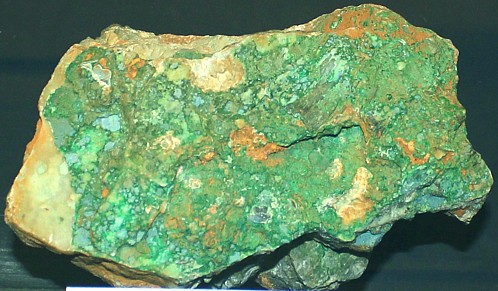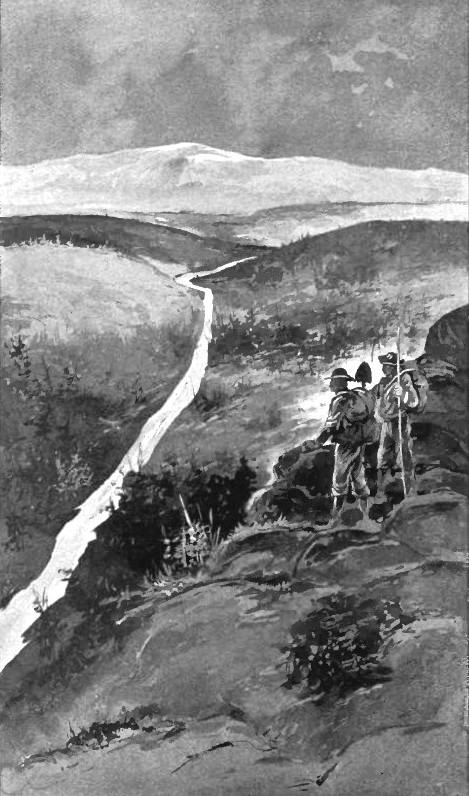New Caledonia is the
world's most productive nickel-bearing region with the exception of the
Sudbury district. The deposits cap serpentine and
peridotite and are covered by ferruginous clay. The ores are
segregated in flat-lying deposits, veinlets, and stockworks. They have
evidently been concentrated by weathering from nickeliferous serpentine and
peridotite. The principal minerals are
garnierite and other nickel silicates. In New Caledonia,
notably in the Thio district on the east side of the island,
nickel ore occurs abundantly in serpentine which has been
formed by the alteration of intrusive peridotites. The ore mineral is
garnierite, occurring as veins and concretionary masses in the serpentine.
The unaltered
olivine rock contains nickel, usually in small amounts,
though specimens have been found containing as much as 21 per cent, of
nickel.
The garnierite deposits of New Caledonia once furnished almost the whole of
the world’s nickel of commerce; but the discovery of nickel bearing
pyrrhotite in great abundance at Sudbury in Ontario has changed that. These
laterite deposits still furnish significant nickel. The original source of
nickel, cobalt, and chromium in the lateritic ores is in the peridotitic and
pyroxenic rocks and in the serpentines derived from them, although traces of
these metals are also frequently noted in analyses of other basic rocks. The
primary condition of the nickel in the rocks is not always known; probably
it occurs both as silicate and as sulphide, the latter in microscopic
grains, the former as an admixture in iron-magnesium silicates.
From the serpentines and peridotites the nickel is sometimes concentrated in
commercially important quantities by processes of weathering and the ores
thus formed are always the green hydrated silicates of nickel. Chromite,
which always occurs in these basic rocks, does not readily yield oxidized
minerals in the zone of weathering. Sulphates of chromium have been observed
in a quicksilver mine in California, but no silicate analogous to garnierite
exists.
Nickel silicates are diverse and uncertain in composition. The most important are genthite, connarite; and garnierite. Such deposits are superficial and the oxidizing surface waters have been the carrying and concentrating agency. The ores rarely extend far below the water-level and in some cases are contained in the residual clays of the completely weathered rock. These nickel ores are often accompanied by cobalt in the form of separate masses of asbolite, a rather indefinite mixture of hydrous oxides of manganese and cobalt. These lateritic nickel deposits do not contain sulfides, and copper ores are rarely present. The accompanying minerals are quartz, chalcedony, opal, and various obscure hydrous magnesium silicates, sometimes also a little magnesite. Nickel ores of this kind are not uncommon, but have attained commercial importance only in New Caledonia. The nickel mines at Riddle, in southern Oregon, where nickel silicate ores are formed from weathering peridotite have been described by several authors. At Riddle, Oregon, the parent rock is a peridotite containing 0.10 per cent, of NiO. The olivine separated from the rock contained 0.26 per cent, of NiO and all observers agree that the nickel ores are formed from this silicate. In the finest joints of the rock silica and nickel-magnesium silicates are deposited, and between them lies the oxidized rock converted to a limonite with some clay and chromite.
One of the two most important nickel-bearing districts of the world is in New Caledonia. The island is about 250 miles long and 30 miles wide; one-third of the area is underlain by post-Cretaceous serpentine and peridotite. The lower slopes are covered by a deep mantle of decayed rock ("variegated clay") which really is an iron ore containing, in per cent., 18 silica, 69 ferric oxide, 0.45 alumina, 1 .64 nickel oxide and 10 water. The garnierite deposits are found at elevations of from 400 to 2,500 feet, sometimes on fairly steep slopes, or in the saddles of ridges and spurs. Underneath the "variegated clay" at depths of from 20 to 75 feet the nickel ores occur often descending into the serpentine along fissures and accompanied by chalcedony and opal. There are many small deposits; the largest contained only 600,000 tons. The ores are worked by open cuts and carefully graded and sorted. Glasser classifies the deposits in vein like, brecciated, impregnations and earthy masses. In the latter there is much dark brown "chocolate ore" in which the green silicate is not visible. The clayey ore averages, in per cent., 23 water, 5-7 nickel oxide, 10-12 ferric oxide, 25 magnesia, 40 silica, no lime, 1.1 chromic oxide, 0.12 cobalt, and 1.5 alumina. Most of the ore is exported. Some of it is sun dried and formed into briquettes for local smelting to 45 per cent, nickel matte with limestone and gypsum flux. The New Caledonia deposits were discovered by the geologist Gamier in 1864; the mines were opened 10 years later, and the cheaply mined rich ores made all nickel deposits elsewhere unprofitable. The richer garnierite of the veins contains from 20 to 45 per cent, of nickel oxide (NiO), but the ore for the most part is much poorer than this. The ore is obtained in surface quarries, and as produced contains on the average not more than six or seven per cent, of nickel. It is in part smelted locally to obtain a rich matte. The ultimate product of weathering of the serpentine in New Caledonia is a red lateritic clay and much of this is associated with the nickel ore. The island also produces much chromite.
OTHER OCCURRENCES. Garnierite deposits closely resembling those of New Caledonia are found at Port Macquarie in New South Wales, and at various localities in Western Australia. Nearly all the nickel mined in Australia comes from Western Australia and this state currently supplies about 13 per cent of the world nickel production. The newer laterite nickel ore projects cheaper to mine because they use new technologies such as high temperature pressurized acid leaching, ion exchange and electrowinning to produce a 99.8 per cent nickel one site at the mine. Laterite ores are difficult to concentrate and require more complex metallurgical processes to extract the values. The new technology being applied in Western Australia uses Pressurized Acid Leach and has the important benefits that they also recover valuable cobalt which is also found in the ore. The new projects use laterite nickel deposits and, being closer to the surface, can be produced by open-cut mining. Laterite nickel ores have also been produced in Madagascar.
A noteworthy occurrence of nickeliferous ore is the rather peculiar type of iron ore at Mayari and other localities on the northern side of Cuba. These nickeliferous iron ores appear to have been formed by the laterization of masses of serpentine containing nickel and chromium. The ore is highly hydrated when freshly quarried, and contains up to 45 per cent, of water. It contains about 1 per cent, of nickel, and between 1 and 2 per cent, of chromium. The dried ore as shipped contains 55-5 per cent, of iron, 4-4 of silica, 14-2 of alumina, 2-1 of chromium, 1 of nickel and only 0.022 of phosphorus. These Cuban ores are smelted in the U.S.A. to obtain a nickel-chromium iron, which, when converted into steel, retains part of the chromium and nearly the whole of the nickel. A somewhat unusual type of ore containing nickeliferous pyrite occurs in the Verkhne-Ufalei district south-east of Revdinsk in the Ural region of Russia. It is a carbonaceous deposit containing 14-85 per cent, of fixed carbon, 26-55 of volatile matter, 35-65 of moisture, and 1-69 of nickel and cobalt. The ash obtained by burning this coaly material constitutes over 20 per cent, of the mass, and contains 7.2 per cent, of nickel. The nickel is present in the form of nickeliferous pyrites, presumably similar or closely related to the nickeliferous pyrites (bravoite) found in the vanadium ore (patronite) of Minasragra in Peru.
Return
to Metal Ores Page:
Precious and Base Metal Ores

Garnierite type silicate nickel ore.

